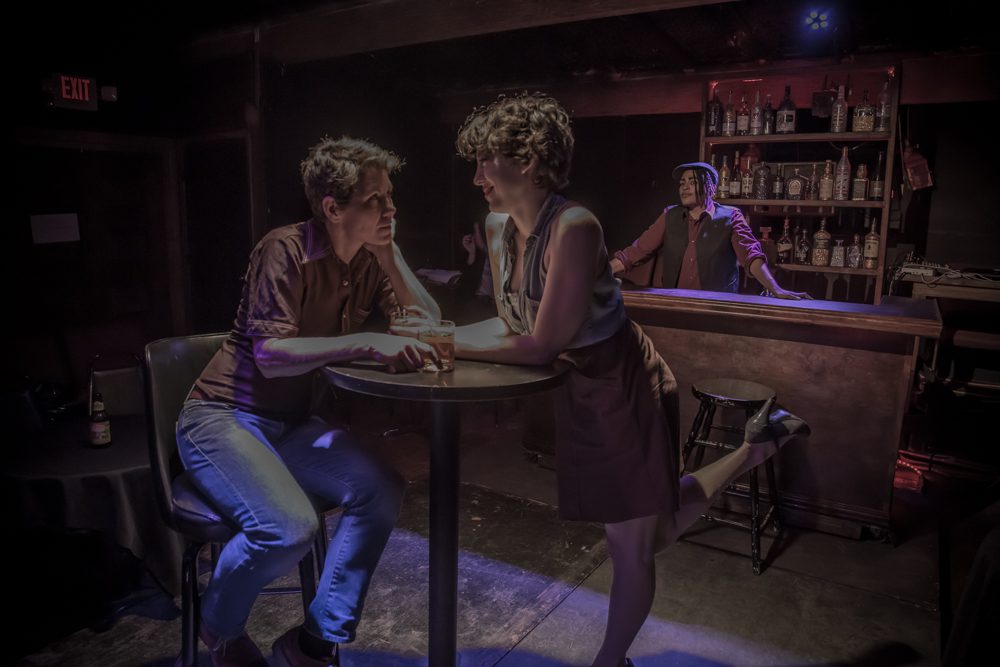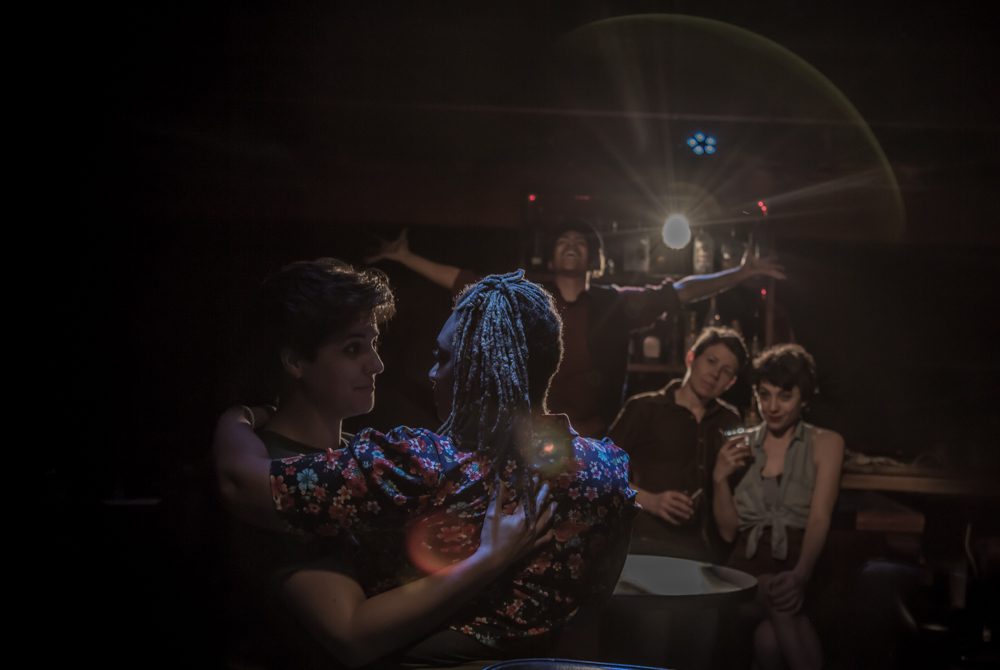Where Have All the Dyke Bars Gone?
Bonnie Gabel, a core organizer of Last Call: New Orleans Dyke Bar History Project, reflects on the process of using performance to revisit and preserve lost histories and spaces.

Lisa Luongo, Erica Langhoff, and indee Mitchell in an preliminary performance of Alleged Lesbian Activities in January 2015 at the Theatre at St. Claude, New Orleans. Photo by Melisa Cardona.
Where have all the dyke bars gone?
From the 1960s into the ’90s, there were more than a dozen lesbian spaces in New Orleans. Les Pierres, Paulette’s, Charlene’s, Brady’s, and so many more were sites of intimacy and resistance for queer women. Dyke spaces all over the country are disappearing, but here, in New Orleans, the lack carries a specific salience. New Orleans has long been a place of pilgrimage for queer people in the largely conservative South. It is where we could come to finally be ourselves. Now, when we arrive, where do we go to find other people like us? Where do we go to find the people who came before us?
I learned about New Orleans’ shuttered lesbian bars three years ago when Rachel Lee, a fellow core organizer of Last Call, passed on a story from our dear friend and mentor Alda Talley about Charlene’s—a dyke spot that used to be on Elysian Fields where Mag’s 940 is now. We had no idea what we had stumbled upon. So we started asking questions.
A team of interviewers and oral historians began working diligently, listening to accounts of these long-shuttered spaces. Early on, we tried enacting the stories, and then started literally dancing to the voices in the interviews. We created a whole piece of choreography to the coming-out stories that we had compiled in our first podcast, a sincere and heartfelt honoring of those who came before us. In response to our sentimentality, some of our interviewees, who lived this herstory, lovingly told us, “That was not what Saturday night was like!” They saw a tribute to their stories, translated through our contemporary lens. They didn’t see themselves. They wanted to see all the glitter and the messiness of the bars embodied. They wanted to be transported back to those spaces.

Erin Roussel, Laurita Marie Ngati, indee mitchell, Lisa Luongo, and Erica Langhoff in a preliminary performance of Alleged Lesbian Activities in January 2015 at the Theatre at St. Claude, New Orleans. Photo by Melisa Cardona.
Bars are complicated, and not everything that goes on inside of them contributes to making our world a more just and peaceful place. Yet they can be tools for liberation when they are activated in the right way. They bring people closer. Bars put people in a room together, which enables them to build community. Making and watching performances can do the same thing.
We began to create a performance that encapsulated the spaces that once sprinkled the street corners of our city. We didn’t know what the end result would be, but we knew we wanted a room of our own, a place to gather that felt comforting, yet sexy, and a little dangerous. A conventional rehearsal room isn’t conducive to the smoky eyes and long meandering conversations like a wood paneled bar, but we found ways to infuse our work with a spirit of play, immediacy, and togetherness. The creative process has been a kind of incantation. We are mediums, pulling up the essence of these spaces. What did they mean to the people who went there, and what do they mean to us now?
We kept searching. We explored the all-night benders that looped between different spaces in the French Quarter and the Marigny. We would frequently do exercises where people moved around the rehearsal space and responded to a facilitator’s directions looking for that Saturday-night feeling. Connect with someone else without using eye contact. One of our choreographers, Jeremy Guyton, put on music and, suddenly, people started colliding into one another, pairing off, cruising, dancing. He leaned over to me and whispered, “I think we found the bar.” After that moment, music became a central element in recreating that lost energy. Bear Hebert, the project’s lead writer, composed ten small poems that were then adapted into song by Rebecca Mwase and Keisha Slaughter. We started to lean on queer traditions of cabaret and drag. We kept singing. We kept dancing.
Three years later, we finally ran a preliminary version of Alleged Lesbian Activities at the Theatre at St Claude. We sold out a week before the performance. Actors entered the space in couples and trios to buy drinks from the wood-paneled bar, and the audience followed suit. When the hosts, Franki (indee mitchell) and MC Privacy (Hannah Pepper-Cunningham), welcomed the audience to “the longest-standing, longest-dancing, longest-drinking, longest-fucking underground lesbian bunker in the city,” the room erupted. The energy was electric. When the performance ended, people wouldn’t leave. Alleged Lesbian Activities became an argument for how essential these spaces are and how much we need them. Spaces for us.
It is hard to describe to people outside the queer community: We have a kind of ecstatic protest. We have gathered and continue to gather in spaces where we can participate in a radical intimacy and joy that many have tried to suppress. It is still not safe for so many queer people in the South. Maybe we don’t need bars, but we do need something. With Alleged Lesbian Activities, we’re calling upon the past in order to push ourselves forward. After decades of dancing our way into a future, one that only we could imagine, we need to reinvigorate the dance floor and begin imagining what an even better world will look like together.
Editor's Note
A preliminary performance of Last Call’s Alleged Lesbian Activities took place January 14 - 16, 2016, at the Theatre at St. Claude. The final version premieres in September 2016.



